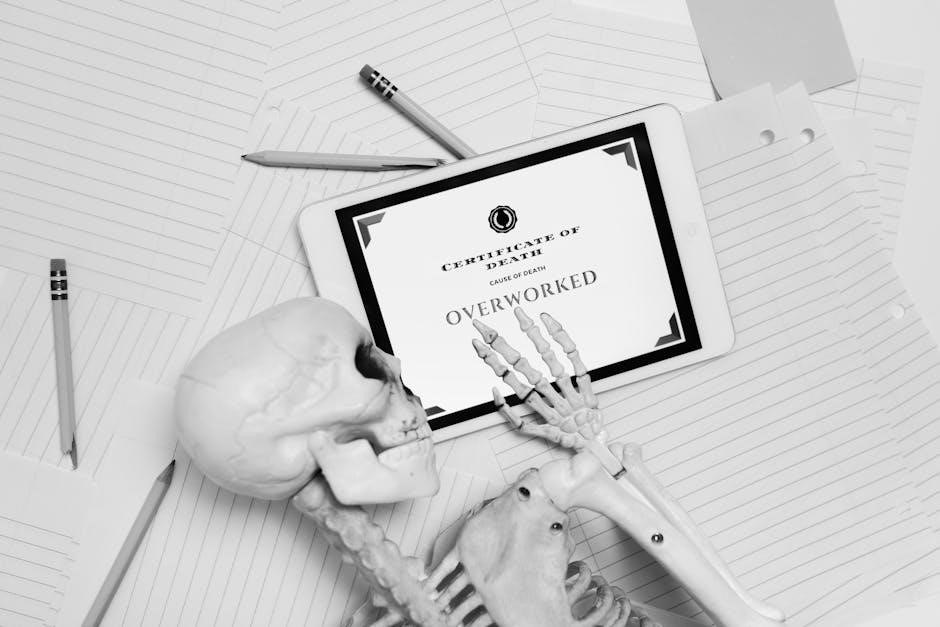Byron Katie’s Work is a transformative method of self-inquiry, offering freedom from suffering through four simple questions. The How to Do The Work PDF guide provides step-by-step instructions, empowering individuals to question stressful beliefs and discover inner peace.
What is The Work?
The Work is a simple yet powerful method of self-inquiry developed by Byron Katie to help individuals identify and question thoughts that cause suffering. It involves four core questions: “Is it true?”, “Can you absolutely know it’s true?”, “How do you react when you believe that thought?”, and “Who would you be without that thought?” By exploring these questions, participants gain clarity and freedom from limiting beliefs, fostering a deeper understanding of their true nature. The Work is not about changing thoughts but about uncovering the truth behind them, leading to peace and self-awareness. It is accessible to anyone willing to engage in honest inquiry, offering a practical path to emotional and mental liberation.
The Origins of The Work
The Work was born from Byron Katie’s personal journey of transformation. Struggling with depression, addiction, and self-loathing, she experienced a profound awakening in 1986. This shift led her to develop a simple method of self-inquiry to help others end their suffering. The Work emerged as a practical tool to question stressful beliefs, offering freedom from emotional pain. Rooted in her own experience, it has since become a global phenomenon, guiding individuals to inner peace. The Work is not just a technique but a reflection of Katie’s deep understanding of the human condition, born from her own struggles and transformation. It continues to inspire millions, proving its timeless relevance and universal appeal.
Byron Katie and Her Philosophy
Byron Katie’s philosophy centers on the belief that suffering arises from believing our thoughts. She teaches that true freedom lies in questioning these thoughts rather than accepting them as true. Her approach, rooted in self-inquiry, encourages individuals to examine their beliefs through four powerful questions. Katie’s philosophy is simple yet profound, emphasizing that no one needs to suffer when they learn to see life as it truly is. She doesn’t offer a set of rules or dogma but invites people to discover their own truth. Her teachings are accessible to everyone, regardless of background, and have inspired millions to find peace and clarity in their lives. Her philosophy is a call to awaken to the present moment, free from the constraints of the mind.

Key Principles of The Work
The Work’s core principles involve investigating stressful thoughts through four questions, fostering self-inquiry, and cultivating awareness to find freedom from suffering and discover true reality.
The Four Questions
The Work revolves around four essential questions designed to examine stressful beliefs: 1) Is it true? 2) Can you absolutely know it’s true? 3) How do you react when you believe that thought? and 4) Who would you be without that thought? These questions guide individuals to question the validity of their thoughts, recognize the emotions triggered, and envision life without the belief. This structured inquiry helps dissolve suffering and reveals a deeper truth. By applying these questions, one can shift perspective and experience liberation from limiting thoughts. The PDF guide offers detailed instructions on applying these questions effectively.
The Importance of Self-Inquiry
Self-inquiry is the heart of Byron Katie’s Work, empowering individuals to examine their thoughts and beliefs critically. By questioning what they believe to be true, people can uncover the root of their suffering and experience profound liberation. The Work encourages a deeper understanding of the mind, fostering awareness and clarity. Through this process, individuals learn to distinguish between thoughts that serve them and those that create unnecessary pain. The PDF guide emphasizes that self-inquiry is not about changing thoughts but about understanding their impact. This practice invites a shift from identification with beliefs to a state of open-minded curiosity, ultimately leading to peace and inner freedom.
Understanding the Role of Awareness
Awareness is central to Byron Katie’s Work, serving as the foundation for recognizing and examining stressful thoughts. It involves cultivating a conscious observation of beliefs without judgment, allowing individuals to see thoughts as mere reflections rather than absolute truths. Through awareness, one gains clarity on how thoughts shape emotions and behaviors. The Work emphasizes that true freedom arises when awareness reveals the distinction between what is real and what is imagined. By fostering this consciousness, individuals can move beyond reactive patterns and embrace a more authentic, peaceful existence. The PDF guide highlights awareness as a meditative practice, encouraging deep introspection and self-discovery.

Preparing for The Work
Preparing for The Work involves identifying stressful thoughts, creating a Judge-Your-Neighbor worksheet, and setting up a quiet space for reflection to facilitate deep introspection and clarity.
Identifying Stressful Thoughts
Identifying stressful thoughts is the first step in The Work. These are beliefs that cause discomfort or tension, often rooted in fear, anger, or sadness. To begin, reflect on situations that trigger emotional reactions. Notice the thoughts that arise and write them down. Focus on statements that feel charged or personal, as these are likely candidates for inquiry. Byron Katie suggests using a Judge-Your-Neighbor worksheet to capture these thoughts. This process helps bring awareness to patterns of thinking that may be contributing to suffering. Once identified, these thoughts can be subjected to The Work’s four questions, allowing for deeper understanding and potential liberation from their grip.

Creating a Judge-Your-Neighbor Worksheet
A Judge-Your-Neighbor worksheet is a tool used to identify and explore stressful thoughts about others. Start by writing down a specific situation involving someone who triggers stress or judgment. Next, list your emotions in that moment, such as anger, sadness, or frustration. Then, write the thoughts that arise, focusing on statements that begin with “They should” or “They shouldn’t.” These statements often reveal underlying beliefs. This process helps clarify the thoughts causing suffering and prepares them for inquiry. The worksheet is a foundational step in The Work, guiding you to question assumptions and uncover the truth behind your reactions. It’s a practical way to begin the journey of self-discovery and inner peace.
Setting Up a Quiet Space for Reflection
Creating a quiet space for reflection is essential for engaging deeply with The Work; Choose a peaceful, distraction-free area where you can sit comfortably and focus on your inquiry. Ensure the space is free from noise and interruptions, allowing you to fully immerse in the process. Consider using a timer to dedicate a specific period to your practice, helping you stay committed and mindful. Keep a journal or worksheet nearby to record your thoughts and insights. The environment should foster calmness and clarity, enabling you to explore your beliefs without external distractions. A serene space supports the introspective nature of The Work, making it easier to connect with your inner truth.

Engaging with The Work
Engaging with The Work involves an active process of self-inquiry, using four core questions to explore stressful thoughts and emotions, fostering clarity and inner understanding.
Asking the First Question: “Is It True?”
The first question, “Is it true?” invites you to examine the validity of your thought without judgment. This step encourages you to look beyond assumptions and seek factual accuracy. It’s not about whether others agree, but about your genuine belief. If the thought feels absolutely true, proceed. If not, note the doubt. This question lays the foundation for deeper inquiry, helping you distinguish between reality and illusion. By pausing to assess the truth, you open the door to freedom from unconscious beliefs. The How to Do The Work PDF guide emphasizes the importance of sincerity in this initial step, ensuring authenticity in your exploration.
Exploring the Second Question: “Can You Absolutely Know It’s True?”
The second question, “Can you absolutely know it’s true?” deepens your inquiry by challenging the certainty of your belief. It asks you to move beyond mere agreement and examine if the thought is undeniably true. Often, what feels true may not withstand this level of scrutiny. This step encourages you to question assumptions and seek clarity. By exploring this question, you may discover that many beliefs are rooted in doubt rather than absolute truth. The How to Do The Work PDF guide highlights the importance of honest reflection here, as it reveals the shaky ground on which many stressful thoughts stand. This questioning fosters a deeper understanding of your beliefs and their impact on your life.
Investigating the Third Question: “How Do You React When You Believe That Thought?”
This question invites you to observe the physical, emotional, and mental effects of holding a particular belief. By examining your reactions, you gain insight into how stressful thoughts impact your well-being and relationships. The How to Do The Work PDF guide emphasizes the importance of honest self-reflection here. It encourages you to list specific behaviors or feelings that arise when you believe the thought. This step reveals how thoughts shape your actions and perceptions, often in limiting ways. Through this inquiry, you may discover that believing certain thoughts leads to unnecessary suffering. The guide offers practical examples to help you apply this question effectively and uncover patterns of reactivity.
Reflecting on the Fourth Question: “Who Would You Be Without That Thought?”
The fourth question guides you to envision life without the stressful thought, revealing your true identity beyond limiting beliefs. The How to Do The Work PDF emphasizes this step as a gateway to self-discovery. By imagining yourself without the thought, you may experience a sense of freedom and clarity. This reflection often reveals that your true self is already present, unburdened by false assumptions. The guide encourages you to explore how life would unfold naturally, without the weight of the belief. This question helps dissolve illusions, allowing you to connect with your authentic being and live more peacefully and authentically.

Examples and Case Studies
The Work addresses various challenges, offering insights into fear, relationships, and health. Case studies in the PDF guide demonstrate practical applications, transforming lives through self-inquiry effectively.
Applying The Work to Fear
Fear is a universal human experience that often arises from believing stressful thoughts. The Work offers a powerful way to investigate and dissolve fear by questioning its root causes. By identifying a specific fearful thought and applying the four questions, individuals can uncover whether the fear is based on reality or merely a product of the mind. For example, if one believes, “I will fail,” they can ask, “Is it true?” and “Can I absolutely know it’s true?” This process reveals how fear distorts perception and creates unnecessary suffering. Without the belief in the fearful thought, the mind naturally returns to a state of clarity and peace. The Work guides individuals to liberation from fear, allowing them to live more authentically and fearlessly.
Using The Work in Relationships
The Work is a powerful tool for transforming relationships by addressing stressful thoughts that lead to conflict. By using the Judge-Your-Neighbor Worksheet, individuals can identify and question beliefs about their partners. For example, if one believes, “My partner doesn’t care about me,” they can ask the four questions: Is it true? Can I absolutely know it’s true? How do I react when I believe this thought? Who would I be without this thought? This process often reveals that such beliefs are not necessarily true and can lead to improved communication and understanding. The How to Do The Work PDF guide provides practical steps for applying these principles in daily interactions, fostering harmony and connection in relationships.
Addressing Health Concerns with The Work

The Work offers a profound approach to managing health concerns by examining the thoughts that amplify stress and anxiety. Byron Katie’s method encourages individuals to question beliefs about their health, such as “I’ll never recover” or “This diagnosis defines me.” By applying the four questions—Is it true? Can I absolutely know it’s true? How do I react when I believe this thought? Who would I be without this thought?—people can uncover the mental patterns fueling their distress. The How to Do The Work PDF guide provides clear instructions for applying this process, helping to reduce fear and foster acceptance. This practice can empower individuals to approach health challenges with greater clarity and peace of mind.

Advanced Techniques
Meditation, journaling, and integrating The Work into daily life are advanced techniques that deepen self-inquiry. These practices, guided by the How to Do The Work PDF, enhance mindfulness and awareness.
Meditation and The Work
Meditation is a powerful complement to The Work, helping individuals dive deeply into self-inquiry. The How to Do The Work PDF guide suggests using meditation to cultivate stillness and clarity, allowing for a more profound exploration of the four questions. By combining meditation with The Work, participants can access deeper levels of awareness, making it easier to identify and question stressful thoughts. This practice encourages a mindset of openness and curiosity, fostering greater insight and emotional release. Regular meditation enhances the effectiveness of The Work, leading to lasting inner peace and transformation. It’s a bridge between inquiry and inner stillness, guiding individuals toward authentic self-discovery.
The Role of Journaling in The Work
Journaling is a key component of The Work, serving as a tool for self-reflection and clarity. The How to Do The Work PDF guide emphasizes the importance of writing down stressful thoughts and beliefs before applying the four questions. This process helps organize the mind and prepare for deeper inquiry. By journaling, individuals can capture their thoughts in a structured format, such as the Judge-Your-Neighbor Worksheet, making it easier to investigate them systematically. Regular journaling also fosters accountability and self-awareness, allowing participants to track their progress and insights over time. It’s a practical way to engage with The Work daily, facilitating emotional release and greater understanding of one’s beliefs.
Integrating The Work into Daily Life
Integrating The Work into daily life involves consistent practice and mindfulness. The How to Do The Work PDF guide offers practical steps to incorporate self-inquiry into your routine, fostering emotional balance and awareness. By dedicating time each day to question stressful thoughts, you can transform recurring patterns of suffering. Start with small moments, such as pausing to reflect during stressful situations or using the Judge-Your-Neighbor Worksheet to process challenging emotions. Over time, this practice becomes a natural part of your mindset, helping you respond to life’s challenges with clarity and compassion. Regular integration of The Work cultivates inner peace and empowers you to navigate life’s complexities with greater ease and understanding.

Resources for The Work
The How to Do The Work PDF guide is a valuable resource, offering practical steps to apply Byron Katie’s four questions and integrate self-inquiry into daily life effectively.
Recommended Books by Byron Katie
Byron Katie’s books offer profound insights into her philosophy and The Work. Loving What Is is a foundational text, sharing her personal journey and the transformative power of self-inquiry. I Need Your Love ౼ Is That True? explores relationships and attachment, while A Thousand Names for Joy delves into living fearlessly. These works provide practical guidance, real-life examples, and inspiration for applying The Work in daily life. For those seeking a structured approach, the How to Do The Work PDF guide complements her books, offering step-by-step instructions for investigating beliefs. Together, these resources create a comprehensive path for understanding and embodying Katie’s teachings.
Downloading The Work PDF Guide
The How to Do The Work PDF guide is a concise resource for understanding Byron Katie’s transformative process. Available for download, it outlines the four key questions and provides practical steps for applying them. The guide is ideal for newcomers and seasoned practitioners alike, offering clarity and simplicity. It serves as a companion to Katie’s books, such as Loving What Is, by breaking down complex concepts into actionable steps. The PDF format makes it easily accessible, allowing users to reference it anytime, ensuring a steady path toward self-inquiry and inner peace. Downloading this guide is a powerful first step in embracing The Work and its life-changing potential.
Online Communities and Support Groups
Online communities and support groups dedicated to The Work offer a vibrant space for connection and growth. These forums provide a supportive environment where individuals can share their experiences, ask questions, and receive guidance from experienced facilitators and practitioners; Many groups host interactive discussions, workshops, and share resources like the How to Do The Work PDF guide. These communities foster accountability and motivation, helping participants stay committed to their journey of self-inquiry. Whether you’re seeking inspiration, practical advice, or simply a sense of belonging, these groups are invaluable for deepening your understanding and application of Byron Katie’s teachings. They embody the spirit of collaboration and collective growth central to The Work.

Implementing The Work
Start by identifying a stressful thought, isolate it, and apply the four questions from the How to Do The Work PDF guide. This simple yet profound process helps you begin your journey of self-inquiry and liberation from suffering.
Starting Small: A Beginner’s Approach
Beginners can start by identifying a single stressful thought and isolating it for inquiry. The How to Do The Work PDF guide provides clear instructions for this process, emphasizing the importance of simplicity and focus. Start with the first question, “Is it true?” and explore it thoroughly before moving to the next. This approach helps build clarity and confidence. Practice with a worksheet, such as the Judge-Your-Neighbor form, to structure your thoughts. Set aside a quiet space for reflection, allowing yourself time to deeply engage with each question. Consistency is key—begin with one thought at a time and gradually expand as you become more comfortable. Patience and curiosity will guide you in unlocking the transformative power of The Work.
Seeking Guidance from Experienced Facilitators
Working with experienced facilitators can deepen your understanding of The Work. These guides offer personalized insights and support, helping you navigate complex emotions and thoughts. Facilitators often provide examples and share their own journeys, making the process more relatable and accessible. The How to Do The Work PDF guide complements this by offering practical tools and step-by-step instructions. Together, the guidance of a facilitator and the structured approach of the PDF create a powerful framework for self-inquiry. Their expertise can help you stay focused and motivated, ensuring you fully engage with the four questions and uncover the wisdom within yourself. This collaborative approach accelerates growth and fosters lasting transformation.
Tracking Progress and Growth
Tracking your progress in The Work helps you see how your perceptions and reactions evolve over time. The How to Do The Work PDF guide suggests keeping a journal to record your insights and shifts in understanding. Reflecting on past inquiries can reveal patterns in your thinking and how your beliefs have softened. Celebrate small victories, like moments of clarity or reduced reactivity to stressful situations. Regularly revisiting your worksheets or sharing your journey with a facilitator can deepen your practice. Progress is not about achieving perfection but about becoming more aware and compassionate with yourself. Over time, you’ll notice greater ease in questioning thoughts and living aligned with your true nature. Growth is a gradual, transformative process.
The Work of Byron Katie offers a profound path to inner freedom. By questioning thoughts, individuals discover peace and clarity, transforming their lives through self-inquiry.
The Transformative Power of The Work
The Work of Byron Katie is a revolutionary process that liberates individuals from the grip of stressful thoughts. By systematically questioning beliefs, people uncover profound truths about their suffering. The four questions guide users to examine thoughts, challenging their validity and revealing the illusions that drive pain. This method fosters deep self-awareness, enabling individuals to break free from limiting patterns. The transformative power lies in its simplicity and depth, offering a path to lasting peace. Many report life-changing shifts in perception, relationships, and overall well-being. The Work is not just a practice but a journey to inner freedom, empowering individuals to live authentically and without unnecessary suffering.
Continuing the Journey of Self-Discovery
Embracing The Work as a lifelong practice, individuals deepen their self-discovery, fostering growth and clarity. The How to Do The Work PDF guide provides a clear roadmap, encouraging daily reflection and mindfulness. By consistently applying the four questions, users cultivate awareness, transforming reactions into responses. This journey reveals the true nature of thoughts and emotions, leading to profound inner peace. The Work becomes a trusted companion, offering tools to navigate life’s challenges with ease. As individuals progress, they often experience increased compassion and understanding, fostering meaningful connections. The journey of self-discovery is ongoing, yet each step brings greater freedom and fulfillment, proving The Work to be a timeless and transformative practice.
